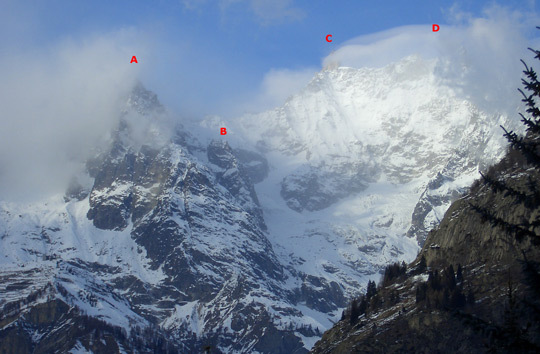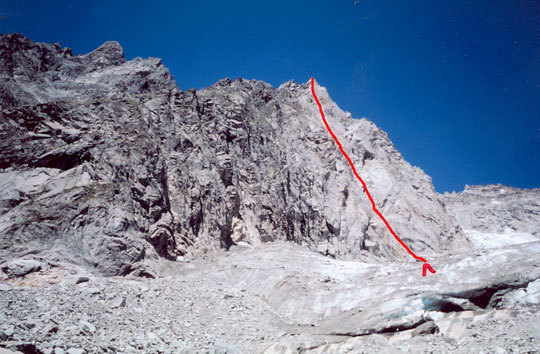
Taken after a period of bad weather, this rather snowy photograph shows the Rochefort Glacier cirque, high above the Val Ferret on the Italian side of the Mont Blanc Range, from the southeast. (A) Dent de Jetoula (3306m). (B) Punta 3095m: the east-southeast face is in profile on the right. (C) Dent du Geant (4013m). (D) Aiguille du Rochefort (4001m). [Photo] Luca Signorelli
Italians Elio Bonfanti, Enrico Bonino, Luca Maspes, Rinaldo Roetti and Paolo Stroppiana have climbed a new route on the east-southeast face of Punta 3095m on the Italian side of the Mont Blanc Massif. This enigmatic granite tower is tucked away on the east flank of the Dent de Jetoula (3306m) above the Rochefort Glacier and has a relatively long and steep approach from the hamlet of Rochefort above the Val Ferret at 1650m. The triangular east-southeast face is a steep and often compact slab of granite around 300m high. The Italians climbed more or less in the center for five pitches to reach poorer rock and the right arete. The route starts with a superb 6a (5.10b) jam crack and then continues up easier ground to overcome a succession of three short 6c (5.11b) corners leading to the base of Pitch 4. This–the crux–is a steep and difficult wall, which can be climbed using ten bolts for aid. A pitch of 5.7/5.8 leads to the finish. Named Diretta allo Scudo, le Demon du Midi, the new route is 250m and 6c A0, 6b+ obl.
Bonfanti was a former climbing partner of the late Giancarlo Grassi, arguably the best and most productive exploratory alpinist ever to come out of Italy. In September 1990, Grassi, with Franco Barus and Michele Ghirardi, put up the first known route on this formation, climbing the right edge of the east-southeast face up slabs that were initially tricky (graded UIAA V and VI [5.7 to 5.9+] at the time) and difficult to protect, then easier ground (III and IV) to the summit (the new Italian route section joins this final section of easy climbing). It was the last route Grassi opened in the Mont Blanc Massif before his untimely death the spring of 1991. He wrote at the time that he was interested in climbing the “shield of slabs” to the left, which are clearly visible from the valley, but sadly he was never able to return.
Subsequently, the idea was forgotten. However, in the summer of 2005 another explorer of forgotten corners in the Massif’s Italian flanks, the British climber Tony Penning, added a second route to the peak when he climbed a corner system up the left side of the “shield”; a direct line on generally excellent rock ending exactly at the summit. Only natural protection was used and the route rappelled (Penning, who continues to prove how much virgin rock still remains in one of the most popular ranges in the Alps, may well have climbed more new routes on the south side of the Massif than any other non-Italian).
Bonfanti has approached the Courmayeur municipality, proposing that Punta 3095m (actually 3093m) be renamed Punta Grassi, in memory of Giancarlo. This may cause a little confusion since it was proposed that Punta 2862m, the granite tower below the south face of the Grandes Jorasses first climbed by Penning in 2006, also be renamed Punta Grassi, as it lies below one of the master’s greatest legacies, the unrepeated and ephemeral Phantom Direct (ED2/3: VI/5, ca. 1100m but 1600m of actual climbing, Grassi-Luzi-Rossi, 1985) on the Tronchey Wall.

Punta 3095m, possibly to be renamed Punta Grassi after the famous Italian alpinist Giancarlo Grassi, seen from the east-southeast during the summer of 2005. The line of the British route is marked. The new Italian route lies to the right, climbing the shield of pale granite just right of the prominent inverted V overhang. [Photo] Tony Penning